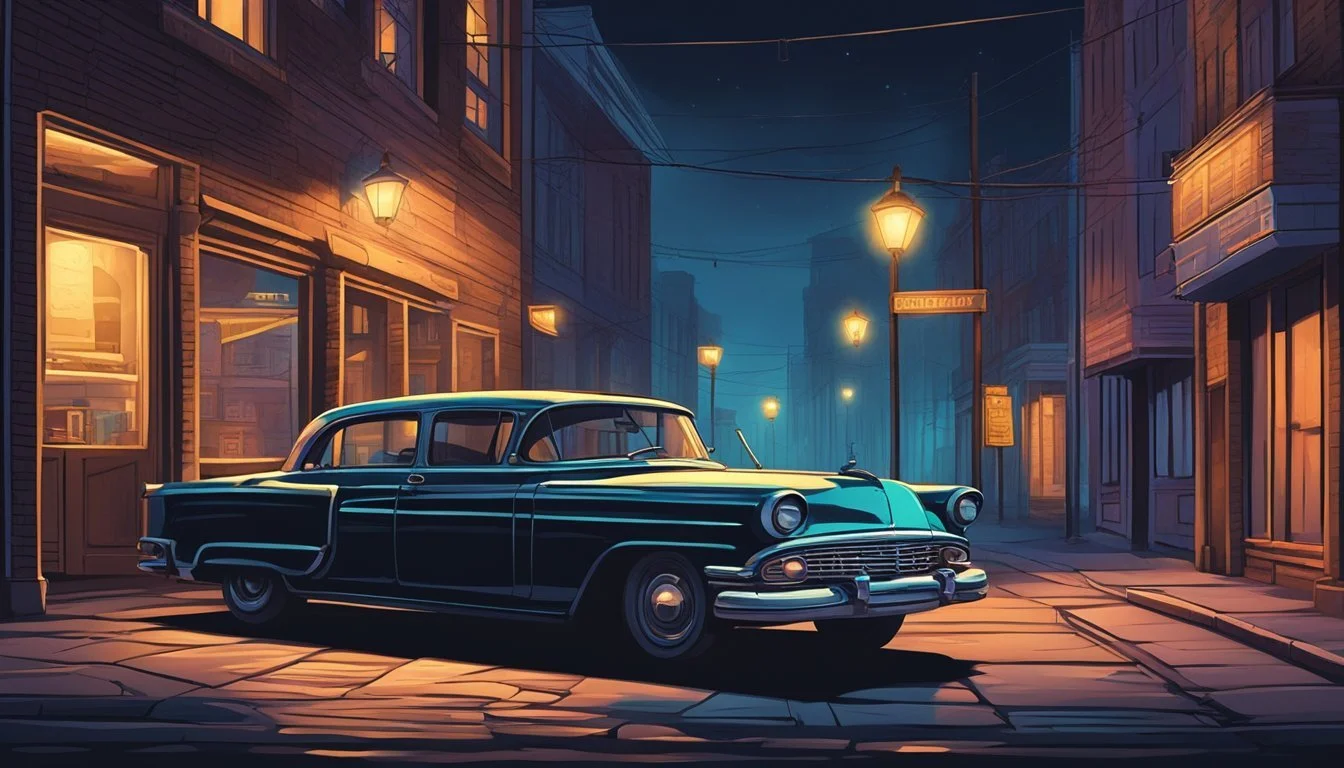Douglas Clark and Carol Bundy: Sunset Strip Killers' Divergent Ends
Justice Served Differently
Douglas Clark and Carol Bundy terrorized Los Angeles in the summer of 1980, earning them the moniker "Sunset Strip Killers." Their brutal crimes targeted vulnerable victims along Sunset Boulevard, shocking the city and leaving a trail of devastation in their wake.
The Sunset Strip Killers' reign of terror came to an end in August 1980, but their fates would diverge dramatically in the decades that followed. Clark, born in 1948, was convicted of multiple charges including murder and sexual contact with human remains. He remained on death row in California until his death in October 2023.
Bundy, born in 1942, took a different path after her arrest. She cooperated with authorities and received a life sentence. Her involvement in the crimes as Clark's accomplice continues to be a subject of fascination for true crime enthusiasts. Bundy passed away in prison in 2003, two decades before her former partner's death.
Profile of Douglas Clark and Carol Bundy
Douglas Daniel Clark and Carol Mary Bundy formed a deadly partnership that terrorized Los Angeles in 1980. Their backgrounds, relationship, and psychological makeup shed light on the factors that led to their violent crimes.
Backgrounds and Personal Histories
Douglas Clark was born on March 10, 1948. He developed manipulative tendencies early in life. Clark's childhood and early adulthood experiences likely contributed to his later criminal behavior.
Carol Mary Bundy, born Carol Peters on August 26, 1942, had a troubled past. She struggled with relationships and personal issues before meeting Clark.
Both individuals had experienced difficulties that may have influenced their eventual descent into violence.
Relationship Dynamics
Clark and Bundy met in 1980, forming an intense and destructive bond. Their relationship was characterized by manipulation and shared dark fantasies.
Clark exerted significant control over Bundy, exploiting her vulnerabilities. Bundy, in turn, became deeply devoted to Clark, participating in his violent schemes.
Their toxic partnership fueled a series of brutal murders along Sunset Boulevard in Los Angeles.
Psychological Portrait
Clark displayed traits consistent with antisocial personality disorder. He showed a lack of empathy and a propensity for manipulation and violence.
Bundy exhibited signs of dependency and possible mental health issues. Her willingness to participate in Clark's crimes suggests a combination of vulnerability and her own dark impulses.
Together, they created a dangerous synergy. Clark's dominance and Bundy's compliance resulted in a lethal duo capable of horrific acts.
Their psychological profiles reveal a complex interplay of individual pathologies and relationship dynamics that ultimately led to their violent spree.
The Sunset Strip Murders
Douglas Clark and Carol Bundy committed a series of brutal killings in Los Angeles during 1980. Their crimes shocked the city and earned them the moniker "Sunset Strip Killers."
Victims and Crime Scenes
The Sunset Strip Killers targeted young women and sex workers in Los Angeles. They murdered at least six victims, though they were suspected in additional deaths.
Most bodies were found dumped along the Ventura Freeway. Some victims were discovered in alleyways near the Sunset Strip.
The killers primarily preyed on vulnerable individuals in the Hollywood area. Their victims ranged from teenage runaways to adult sex workers.
Modus Operandi
Clark and Bundy used a distinctive method in their murders. They would cruise the Sunset Strip looking for potential victims.
Clark would pick up women, often sex workers, and shoot them during sexual acts. He then engaged in necrophilia with the corpses.
Bundy assisted Clark by helping dispose of bodies and clean up crime scenes. She also participated directly in at least one murder.
The pair kept souvenirs from their victims, including personal items and body parts. This trophy-taking behavior is common among serial killers.
Notable Incidents
One of the most infamous crimes was the murder of two teenage stepsisters. Clark picked them up and shot both girls execution-style.
In another shocking incident, Bundy decapitated one of Clark's victims. She kept the severed head in her refrigerator as a grotesque memento.
The final murder involved Bundy killing her former boyfriend. She shot him after he threatened to expose the couple's crimes.
This last killing ultimately led to the downfall of the Sunset Strip Killers. Bundy confessed to police, implicating herself and Clark in the string of murders.
The Investigation
The investigation into the Sunset Strip Killers unfolded through law enforcement's swift response, meticulous evidence collection, and a crucial breakthrough leading to arrests. Multiple agencies collaborated to piece together the puzzle of these brutal crimes.
Law Enforcement's Response
Los Angeles police sprang into action after the discovery of the first victim on June 12, 1980. Detectives from the LAPD Homicide Division took charge, recognizing the potential for a serial killer case. The Los Angeles County Sheriff's Department joined the effort as more bodies were found.
Investigators worked tirelessly, interviewing witnesses and canvassing areas where victims were last seen. They established a task force dedicated to solving the murders, pooling resources from various departments.
Collection of Evidence
Forensics teams meticulously gathered evidence from crime scenes. They recovered shell casings, bullet fragments, and fibers. DNA analysis, though limited at the time, provided some leads.
The Los Angeles Times reported that all victims were shot in the head with the same gun. Ballistics experts confirmed this, linking the murders to a single weapon.
Detectives collected surveillance footage from businesses along Sunset Boulevard. They also gathered financial records and phone logs of suspects.
Breakthrough and Arrests
The case broke when Carol Bundy confessed to her co-worker about the murders. This led to her arrest on August 9, 1980. She implicated Douglas Clark as her accomplice.
Police quickly apprehended Clark at work. Searches of their residences yielded crucial evidence, including the murder weapon and personal belongings of victims.
Investigators found Clark's fingerprints on items connected to the crimes. Bundy's detailed confession provided a timeline of events and locations, corroborating physical evidence.
Trials and Convictions
Douglas Clark and Carol Bundy faced severe legal consequences for their brutal crimes. The judicial process involved multiple stages, including trials, appeals, and testimonies that shed light on the horrific nature of their actions.
Doug Clark's Trial
Clark's trial began in 1983 and lasted several months. He chose to represent himself, attempting to shift blame onto Carol Bundy and Jack Murray. Clark faced charges of first-degree murder for six victims.
The prosecution presented overwhelming evidence, including physical evidence and witness testimonies. Clark's defense strategy proved ineffective, and he was found guilty on all counts.
In 1983, the jury recommended the death penalty. The California Supreme Court upheld his conviction and sentence in 1990.
Carol Bundy's Plea and Testimony
Carol Bundy initially pleaded not guilty but later changed her plea to guilty. She agreed to testify against Clark in exchange for avoiding the death penalty.
Bundy's testimony provided crucial details about the murders and Clark's involvement. She described their relationship and the events leading up to the killings.
As a result of her plea deal, Bundy received a sentence of 52 years to life in prison. Her testimony played a significant role in securing Clark's conviction.
Public and Legal Reactions
The trials of Clark and Bundy garnered significant public attention. The brutality of their crimes shocked the community and raised questions about public safety.
Legal experts debated the effectiveness of Clark's decision to represent himself. Many viewed it as a poor strategy that likely contributed to his conviction.
The case highlighted the complexities of prosecuting serial killers and the importance of forensic evidence. It also sparked discussions about the death penalty and its application in California.
Incarceration and Sentences
Douglas Clark and Carol Bundy received lengthy prison terms for their brutal crimes. Their incarceration involved different facilities and divergent outcomes over the decades that followed their convictions.
San Quentin State Prison
Douglas Clark was sentenced to death in 1983 for six murders. He was transferred to San Quentin State Prison's death row to await execution. Clark spent over 40 years confined in the notorious prison north of San Francisco.
San Quentin housed California's male death row inmates. Clark lived in a single cell, with limited time outside for exercise and showers. He had access to the prison law library and was permitted visits from legal representatives.
Despite his death sentence, Clark was never executed due to California's moratorium on capital punishment. He remained on death row until his death from natural causes in 2023.
Appeals and Parole Attempts
Clark filed multiple appeals over the years, claiming innocence and alleging legal errors in his trial. His efforts to overturn his conviction were unsuccessful.
Key points of Clark's appeals:
Challenged forensic evidence
Claimed ineffective assistance of counsel
Argued jury misconduct
California's suspension of executions in 2019 eliminated Clark's immediate risk of execution. However, he remained ineligible for parole due to his death sentence.
Clark died of heart failure at age 75 in October 2023, still incarcerated at San Quentin. His decades-long legal battles ended without achieving freedom or exoneration.
Carol Bundy's Incarceration
Carol Bundy received a life sentence without the possibility of parole. She was imprisoned at the California Institution for Women in Chino.
Bundy's incarceration differed from Clark's in several ways:
No death sentence
Housed in general prison population
Access to work programs and education
Despite her life sentence, Bundy became eligible for parole consideration due to changes in California law. She was denied parole multiple times.
Bundy died in prison in 2003 at age 61 from heart failure. She had served 23 years of her life sentence at the time of her death.
Media and Cultural Impact
The Sunset Strip Killers case left an indelible mark on popular culture and true crime media. Their crimes sparked public fascination and inspired various forms of artistic expression.
Literature and True Crime
Louise Farr's book "The Sunset Murders" provided an in-depth examination of the case. Published in 1992, it offered readers a comprehensive look at Clark and Bundy's crimes. The book explored their backgrounds, motivations, and the investigation that led to their arrests.
True crime television shows featured the Sunset Strip Killers. Episodes on popular series like "Forensic Files" and "Deadly Women" brought renewed attention to their crimes decades later. These programs often focused on the forensic evidence and psychological profiles of Clark and Bundy.
Public Perception and Influence
The Sunset Strip Killers case heightened public awareness of safety concerns in Los Angeles. It sparked discussions about vulnerable populations, particularly sex workers, who were targeted by Clark and Bundy.
The involvement of Carol Bundy, a seemingly ordinary woman, in such heinous crimes challenged societal perceptions. Her role as an accomplice raised questions about the nature of evil and the potential for anyone to become involved in criminal activities.
The case also influenced legal proceedings. Clark's claims of innocence and multiple appeals kept the case in the public eye for years. This prolonged legal process highlighted issues within the criminal justice system and the challenges of death penalty cases.
Analyzing the Legacy
The Sunset Strip Killers case left a lasting impact on crime prevention efforts and the criminal justice system. Their crimes exposed vulnerabilities in public safety and highlighted the complexities of prosecuting team killers.
Crime Prevention and Awareness
The Clark and Bundy murders sparked increased vigilance in Los Angeles. Law enforcement bolstered patrols along Sunset Strip and surrounding areas. Community watch programs expanded, with a focus on protecting sex workers and young women.
Hotels and motels implemented stricter security measures. Public awareness campaigns educated citizens about the dangers of hitchhiking and accepting rides from strangers. Schools and parents emphasized personal safety to teenagers.
The case also led to improved communication between different police jurisdictions. This helped connect seemingly unrelated crimes and identify patterns in serial killer cases more quickly.
Reflections on the Criminal Justice System
Clark and Bundy's trials revealed challenges in prosecuting team killers. Prosecutors had to prove individual culpability while demonstrating their collaborative nature. This case influenced legal strategies for future serial killer prosecutions.
The insanity defense, though unsuccessful for Clark, prompted discussions about mental health evaluations in criminal cases. It highlighted the need for more comprehensive psychiatric assessments of violent offenders.
Sentencing disparities between Clark and Bundy raised questions about gender bias in the justice system. Clark's death sentence contrasted with Bundy's life imprisonment, despite her involvement in multiple murders.
The case also underscored the importance of forensic evidence in solving complex crimes. It encouraged further investment in forensic technology and training for law enforcement.





